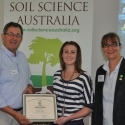05 Dec 2014
World Soils Day
December 05, 2014

December 05 is World Soils Day, which is a day to recall the role that soil plays in our life and culture. A full list of Australian events can be found at the Soil Science Australia website - http://www.soilscienceaustralia.com.au/
Soil Science Australia published as special edition of Soil Science Australia (Issue 2, 2014) to collect some information on the various dimensions of soils and their impact. Below is my contribution on the link between soils and our health.
Soils and our nutrition
Robert Norton, International Plant Nutrition Institute, Australia and New Zealand
Farmers produce 35 to 40 Mt of wheat, barley, canola and other grains worth around $8 billion, along with sugar, cotton, wine products and horticultural crops, worth another $11 billion. The Australian beef, sheep and dairy industries combine with the cropping industries to contribute $45 billion to our economy.
But the contribution is more than just economic. Our lives and well being are intimately tied to the food we eat. Our farmers have an enviable record of producing good quality, nutritious food for Australians as well as our international trading partners.
The grains, meats, oilseeds, sugar, fruit and vegetables all provide the energy, protein, fats, vitamins and minerals we need to keep us healthy. The ability of crops to produce nutritious foods depends directly on soil fertility, which is the ability of the soil to sustain healthy plant growth. Soil fertility is a combination of physical (soil structure, air and water), biological (living and dead organic materials) and chemical (the concentration of nutrients and other materials) components that together enable the soil to meet plant demands.
Minerals from the soil are the basis of soil fertility, with nitrogen, phosphorus and potassium required in large amounts, while calcium, magnesium and sulfur are essential but needed in smaller quantities. The micronutrients zinc, iron, copper, manganese, boron, chlorine, nickel and molybdenum are also essential for both plants and animals, while iodine, cobalt and selenium are essential for animals but not plants. Some plants also need silicon.
The pathway to our plates for all these nutrients is from the soil, to the plants and then into the food we eat. If the soil lacks essential nutrients, then the food produced will not support our good health.
The mineral nutrients taken up by plants have to come from the soil, and all of them are derived from mineral or organic fractions of the soil. The minerals can be derived directly from the rocks from which the soils are derived or from salts deposited as the soil formed. Organic matter comes from dead and decaying plant material where nutrients are recycled through uptake and then release.
Nitrogen is something of a special case, because legumes like peas and clovers, can convert atmospheric di-nitrogen to an organic form, which then becomes reactive nitrogen, which then cycles back into other plants and onto animals.
Because plant nutrients are removed from the farm in agricultural produce, farmers use fertilizers to replace those removed. For example, each tonne of wheat produced will take with it around 22 kg of nitrogen, 3 kg of phosphorus and 1.5 kg of sulfur. Smaller amounts of the micronutrients are also removed. Unless replaced, the soil reserves become depleted and if reserves are limited, then the performance of subsequent crops and pastures will be adversely affected. It is estimated that without mineral fertilizers, production would at least halve.
In Australia, fertilizers containing phosphorus and/or nitrogen are used to balance their removal in produce. Australia uses around 5 M t of fertilizers of all types each year, which includes supplies of around 1 M t of N and 0.45 M t of P in forms that plants can access and use efficiently to balance product removal.
Under application means that soil reserves decline, which reduces subsequent production and lowers on-going soil fertility. For some soils, there are large reserves of nutrient like potassium, or the removal may be insignificant like copper, so that their export from the paddock has little impact. For others, like nitrogen, deficiencies can develop rapidly and significantly affect crop yield, farm profitability and soil health through the depletion of soil organic matter.
In some situations, application rates used by farmers can be higher than the amount removed. Some nutrients can be transferred from the paddock in water or attached to soil particles, and both losses can cause environmental issues in areas where the water or soil is deposited. Nitrogen fertilizers can also be lost as ammonia gas, the greenhouse gas nitrous oxide or converted back to non-reactive di-nitrogen, and the end product is a consequence of the soil and environmental conditions that occur when the nutrients are applied.
However, application rates above removal may also be used to build up soil nutrient status. Many Australian soils have a relatively low native phosphorus status and applications over time have increased the levels to where removal as crop products may only need to be replaced with fertilizer. Some soils also convert soluble nutrient sources like phosphate to insoluble or fixed forms that are not available to the crop, so again, application rates need to consider soil fixation to ensure crops are well supplied.
The increasing use of fertilizer in agricultural crops has boosted production per unit area, increased the total supply of food as well as contributing to the quality of food and its content of essential micronutrients such as zinc. Soils across much of Australia are particularly depleted in zinc, which is essential in human as well as plant nutrition. Diets deficient in zinc lead to complications during pregnancy and childbirth, low birth weight and poor growth in childhood as well as reduced immuno-competence and increased infectious disease susceptibility.
Bio-fortification of crops can be an effective strategy for moving large numbers of people from deficient to adequate zinc nutrition. The use of supplementary zinc on crops like cereals can increase crop yield as well as grain zinc concentration, leading to improved human zinc status for some of the 20% of the population at risk of inadequate zinc intake.
Applying nitrogen to cereals adds to the protein concentration in the grain produced, as well as increasing the grain yield. Enhanced protein concentration improves the concentrations of gluten, which confers the functional properties on breads and pastas, and the management of nitrogen is as important as the amount applied. Research to identify the optimum source, rate, timing and placement of nitrogen will contribute to the production of nutritious products.
The balance of nutrients supplied is also important, and much of the focus of farmers is to balance nutrition so that all the essential nutrients are supplied. The balance of nitrogen and sulfur is particularly important for wheat, because the unique proteins that make dough extensible need both elements in the ratio of around 15:1 for good baking quality.
Sulfur itself is an important part of plant and human nutrition like all essential nutrients. Crops grown on sulfur deficient soils suffer reduced yield as well as poor product quality. Sulfur is a present in the essential amino acids cysti(e)ne and methionine which cannot be synthesized by higher animals. Methionine is an initiating amino acid in many eukaryotic proteins, and cyst(e)ine plays a critical role in protein structure through the formation of disulfide bonds. Sulfur rich compounds have also been identified as conferring a range of health benefits including the organic compounds in garlic (allyl cysteine sulfoxide and onion (capenes and thiosulfates) and the glucosinolates in brassicas like mustard. They also make things taste good.
The recognition of the health benefits of particular crops has led to them being termed functional foods – a feature related to health improvement over and above the supply of protein, carbohydrate and fats. The levels of nutrients like calcium, magnesium and potassium in foods is intimately linked to the amounts supplied from the soil. Fertilization with mineral and organic nutrient sources, and amending soil acidity with lime contributes to meeting the requirements in human nutrition.
The future of feeding our population with adequate and nutritious foods depends intimately on the supply of nutrients to the crops. Soils alone are not able to meet this supply indefinitely as the nutrients removed in the crop products are not returned to where the crops were grown. Good agricultural practice will at least replace the nutrients removed in produce, and then seek to develop strategies to select the most appropriate nutrient source, applied at the right time, at the right rate and in the right place. The health of our human family depends on the health of the soil, and the soil must be supplied with a balanced supply of nutrients to be healthy. We are what we eat, and what we eat comes from the soil we need to nurture.
For more information see:
Bell RW and Dell B. 2008. Micronutrients for sustainable food, feed, fibre and bioenergy production. International Fertilizer Industry Association, Paris, France. 174 pp. (available at
Bruulsema T, Heffer P, Welch RM, Cakmak I, and Moran K. (eds). 2012. Fertilizing crops for human health: A scientific review. International Plant Nutrition Institute, Norcross, Georgia, USA. 290 pp.




